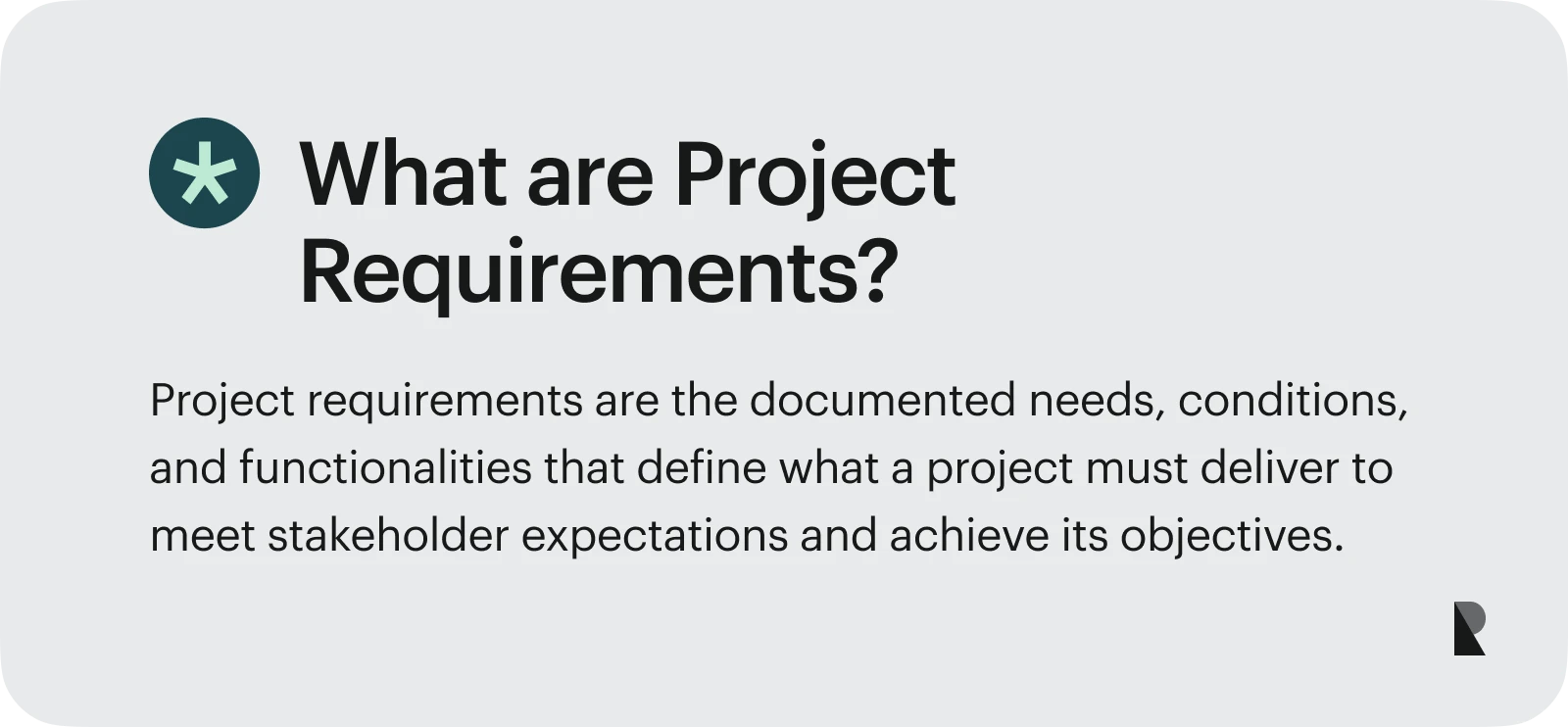
Everyone wants a project to succeed, but defining "success" can be challenging. Stakeholders often have a vague vision, which turns into poorly translated project requirements for their teams. This leads to miscommunication, team frustration, and, ultimately, failure.
In fact, 47% of organizations fail to meet their business goals due to poor requirements management. And this figure climbs up among low-performing organizations. So how do you mitigate this risk? By understanding what project requirements are and how to manage them successfully.
What are Project Requirements?
Project requirements outline what needs to be met for a project to succeed. Think of it as a comprehensive checklist you get to tick every step of the way as you— slowly but surely—inch towards the finish line. But it has to be crafted strategically.
Well-documented requirements make it easier for project managers to plan, implement, and allocate resources effectively. They keep you in control, ensuring you remain on track and aligned with everyone.
Types of project requirements
There are four types of project requirements based on the nature of needs:
- User or stakeholder requirements: End-user needs, like allowing users to filter products by size and color in an e-commerce app.
- Business requirements: Organizational needs, like increasing web traffic by 20 percent and online sales by five percent.
- Transition requirements: These requirements enable the project to move from one state to another, such as training users on new SaaS software.
- Solution requirements: These requirements can be categorized as functional and non-functional. The former refer to requirements that directly impact the function of a product or a system. An example is a mobile shopping app featuring a Checkout function with a one-click payment system. In contrast, the latter relates to qualities of a product or system. For example, a website's home page must load within 30 seconds.
Project Scope and Deliverables
Project scope, deliverables, and requirements affect each other.
The scope of your project sets its boundaries. For example, a small-scope productivity app for a 100-employee company greatly differs from one catering to millions of users. The larger the scope, the more requirements you need to fulfill.
Meanwhile, project deliverables are the results stakeholders expect to achieve upon completion. These can be your KPIs or a tangible product, to name a few. That said, project deliverables must align with your requirements.
So, it is essential to balance deliverables, scope, and requirements. Below are some tips to consider:
- Create a scope statement that clearly defines the boundaries of a project and who's responsible for what.
- List all requirements and deliverables in a shareable file for the team to refer to. This prevents confusion and unapproved changes along the way.
- Establish a workflow system for feedback and other processes to keep everything under control.
Requirements Gathering Process
The first step towards a successful project is requirements gathering. However, it is often overlooked because many assume it is merely a list of tasks and needs that come to mind.
How you gather requirements lays the groundwork for the entire project. It requires a more thorough and thoughtful process, broken into three phases: needs identification, analysis, and requirements approval.
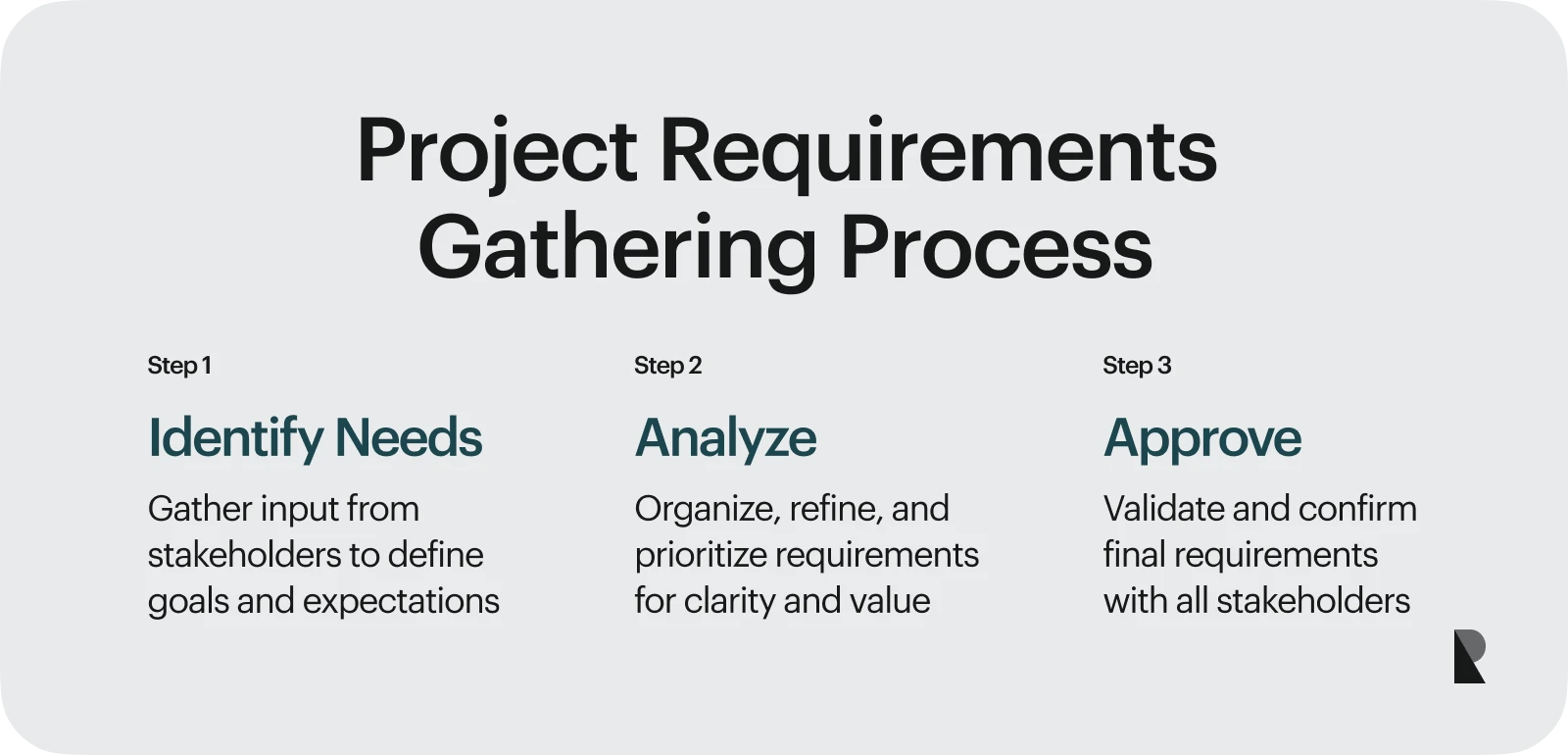
Needs identification
Requirements gathering starts by consulting key stakeholders—clients, users, team members, and others—to understand their vision, needs, and expectations. This stage involves conducting surveys, interviews, or meetings to collect ideas. For example, if launching an app for a cat grooming salon, ask pet owners what features they want to see.
Analysis
Analyze the gathered information to determine the requirements. Document all requirements comprehensively, including business, functional, and non-functional needs. Check for redundancies and conflicts, too. For instance, you may realize the app needs to send appointment reminders at specific times.
Use prioritization techniques like cost-benefit analysis or the Kano model to identify which requirements should make the final list based on ROI and projected user satisfaction.
Approval
Present the finalized requirements to stakeholders for approval. Engage them throughout the gathering process and hold review sessions before finalizing. Use transparent project management tools to gain their sign-off. Once approved, schedule requirements by order of priority so your team knows what to focus on.
Finally, prepare for potential risks and establish clear communication to avoid conflicts. Now, let's move to managing requirements.
Key Processes in Managing Project Requirements
Proper management of requirements can directly impact results. Here are foundational steps you can take to ensure a seamless process.
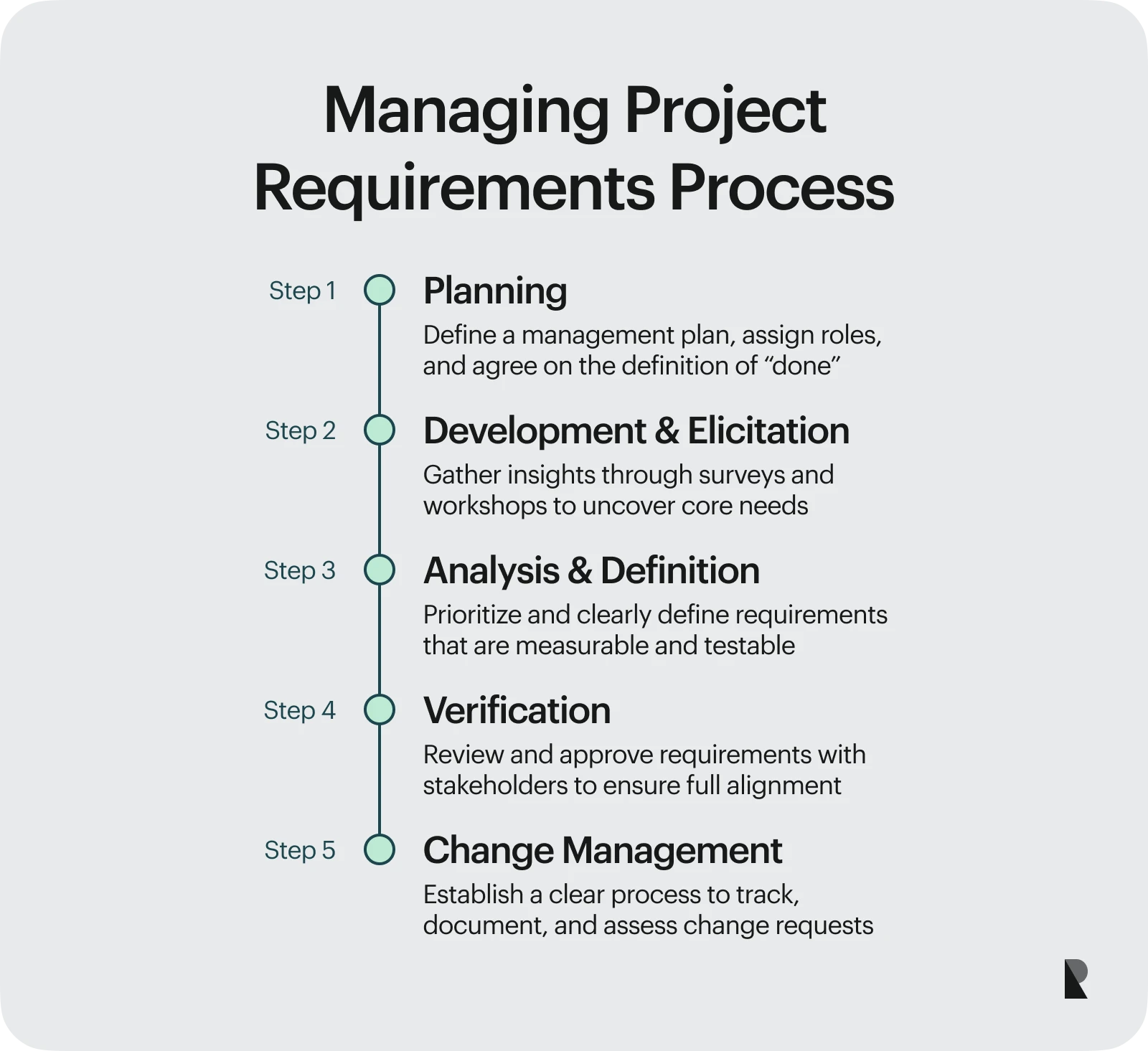
1. Planning
A Requirements Management Plan includes breaking down tasks and assigning them to team members. It also details mechanisms for tracking and documenting what needs to be done when changes occur. It is a roadmap for the project team to deliver on stakeholder needs.
At this stage, it is crucial to identify the right tools for gathering information and sharing documents. Stakeholders should also agree on the definition of "done" when accomplishing requirements.
2. Development and elicitation
With an initial plan in place, the next step is to gather the necessary information and feedback for the project requirements. This can be done through surveys, workshops, or interviews, ensuring you have the right tools.
When qualifying what can be included in the requirements, you'll need to delve deeper and identify the core underlying needs. Ask yourself what the root problem you are trying to address is.
3. Analyzing and defining requirements
Categorize requirements into must-haves and good-to-haves and into different types of requirements—functional, non-functional, business, etc. This helps the team focus on what matters for the project, especially when faced with limited resources and other constraints.
Define project requirements using statements that are specific, measurable, and testable. For instance, write "The product images should load in under five seconds" instead of "The product images should come up quickly."
4. Verification
Before finalizing requirements, seek stakeholder approval to ensure alignment with the organization's goals and overall vision. This step involves setting up several meetings with stakeholders to review requirements and confirm they are up to standard.
5. Change management
Requirements may change over time as business goals and consumer demands evolve. Establish a process for managing change requests, including documenting each change (what), the requestor (who), and the rationale (why). Schedule periodic measurement of these changes to the budget, timeline, and other project aspects.
Requirements Approaches: Waterfall vs. Agile Project Requirements
How one manages project requirements differs based on the project approach. Let's look into two common project approaches and their impact on the identification and implementation of requirements.
Waterfall project requirements
The waterfall approach is linear, following a fixed sequential process. It starts with gathering requirements, designing, building, testing, and delivering the product. Everything is determined upfront with an understanding that no changes will be made once the project begins.
This makes tracking the status of requirements easier, as you don't move to the next step until the first requirement is fulfilled. Clear task separation and detailed documentation also help.
However, the waterfall approach's inflexibility can be problematic. If issues are not identified early, they can be costly to rectify. Thus, it's crucial to spend significant time upfront gathering detailed requirements and planning each step before project kickoff.
Agile project requirements
Meanwhile, the agile approach breaks the project into parts or "sprints," allowing the team to set and fulfill requirements as the project evolves. Agile project requirements are flexible. They can be changed when the situation calls for it. This also makes close collaboration all the more critical.
Agile project requirements require active involvement from end-users to gather sufficient feedback for each project phase. For example, if you are developing a new mobile app, you need active input and engagement from end-users to track their expectations and demands during development.
With agile, reviewing progress frequently and adjusting requirements as needed is vital.
Requirements Gathering Tools
Once you know which approach to implement, the next step is to identify the tools you can use to understand the project's needs best.
- Focus groups and interviews: Gather feedback from users and stakeholders in a group setting or through one-on-one interviews to learn what they want and need.
- Surveys or questionnaires: Send a list of questions to as many people as possible within your target audience to gather opinions and thoughts on your project.
- Document analysis: Review existing documents and reports to identify patterns and locate key information that can help determine requirements.
- Observation: Understand your target audience by observing how they interact with your product.
- Use cases or user stories: Create stories for each customer persona, exploring scenarios on how they could interact with the product.
Product Requirements Document (PRD)
Bridge the gap between high-level project goals and methodologies for successful project implementation with a Product Requirements Document (PRD).
What is a PRD and what does it include?
A Product Requirement Document (PRD) is a comprehensive guideline that helps the team understand what a product should do and how it should function. It lists all product features and functionality requirements, purpose, and how the product behaves and looks. It also outlines the product's goals and priorities, breaking them down into steps that cross-functional teams can follow until the product's release.
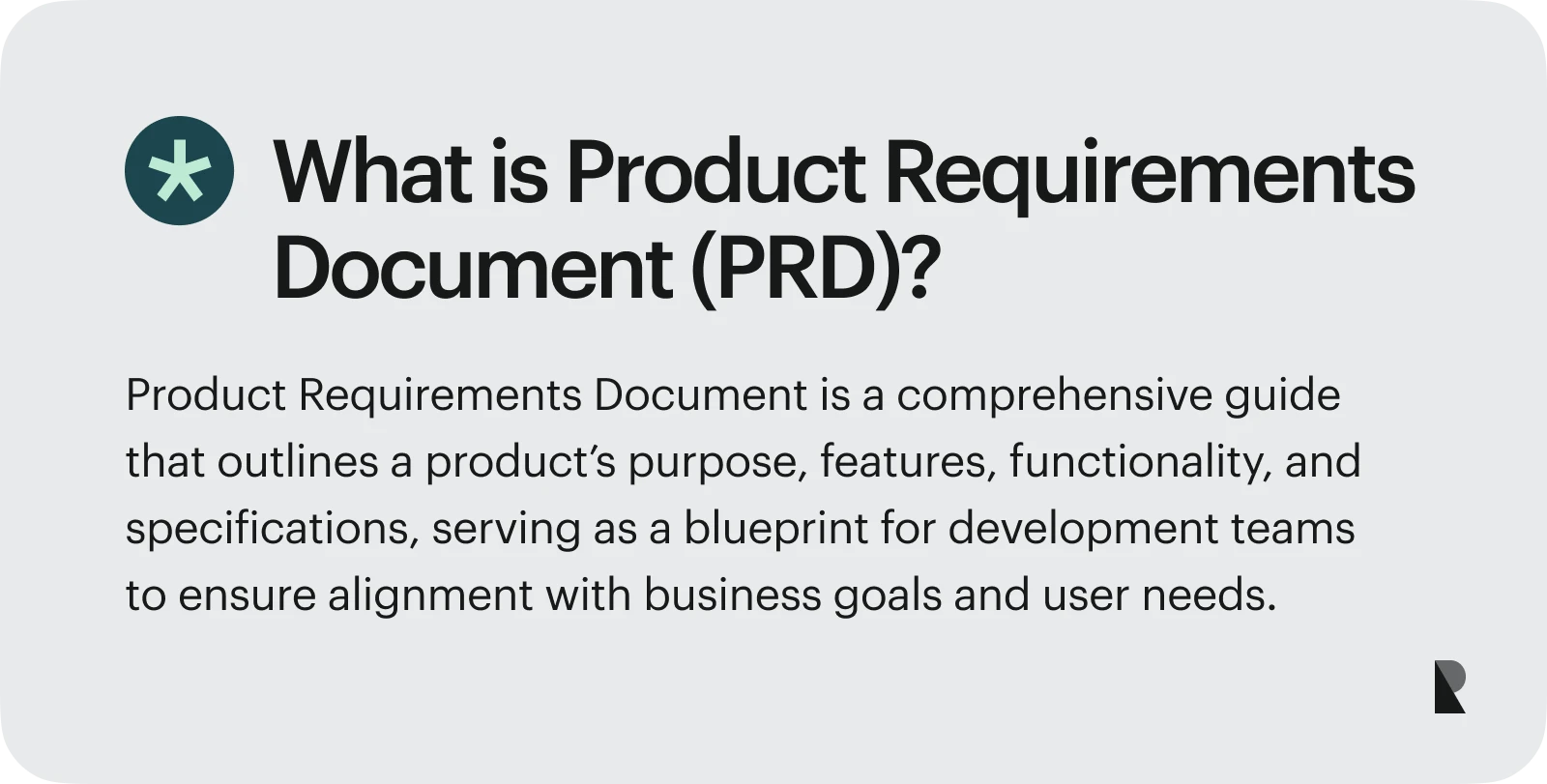
Here's a checklist of what a product requirements document should include.
- Product purpose and scope
- Target audience
- Detailed list of requirements
- Limitations and other assumptions
- Success metrics
- Product timeline
Why PRD matters for agile work
In agile work, the PRD guides the team to work on prioritized requirements in every sprint or short cycle. A PRD also identifies and documents constraints, like resource availability, timeline, and regulatory requirements, ensuring the product development and design are realistic and achievable.
This allows the project team to work efficiently, remain versatile, avoid confusion, and optimize resources and results.
Tips for creating effective PRDs
A product requirements document is effective when it clearly communicates and aligns the product's goals, scope, and requirements to key stakeholders. It should be comprehensive by covering requirements and allowing for updates as the project evolves without losing focus.
Below are some tips you can implement to achieve this.
- Be clear and concise when stating product goals and how success will be measured.
- Learn how to prioritize requirements based on their importance to avoid scope creep and return on investment.
- Set measurable indicators for each requirement to determine when it's complete and whether the results meet expectations.
Examples of PRDs to Inspire You
Loom’s comprehensive product requirements document
Loom’s Product Requirements Document thoroughly addresses all aspects of a project. Its highly structured sections help organizations define goals, features, and even success metrics. The document also includes prompts for easier articulation of project needs and expectations, reducing ambiguity and ensuring alignment between teams.
Another notable feature of the PRD is the Notes section, where the team is encouraged to gain a deeper understanding and conduct additional surveys or interviews with target users. This highlights the importance of keeping the PRD updated and relevant as the project goals change.
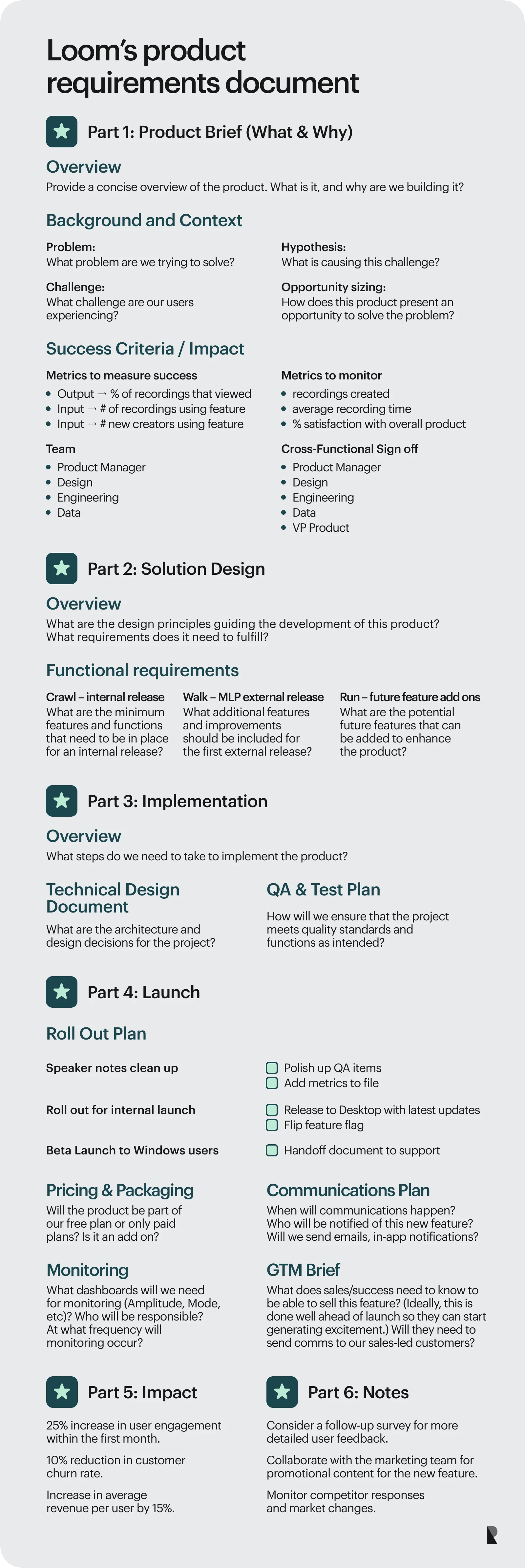
Lenny Rachitsky’s PRD
Not all PRDs have to be as comprehensive as Loom’s. You may benefit from Lenny Rachitsky’s one-pager PRD if you have a not-so-complicated project. Its straightforward design clarifies the key problems the project aims to solve. It also emphasizes the importance of focusing on essential features first to save time and money. However, remember that although the template is simple, its effectiveness relies on conducting heavy user research.
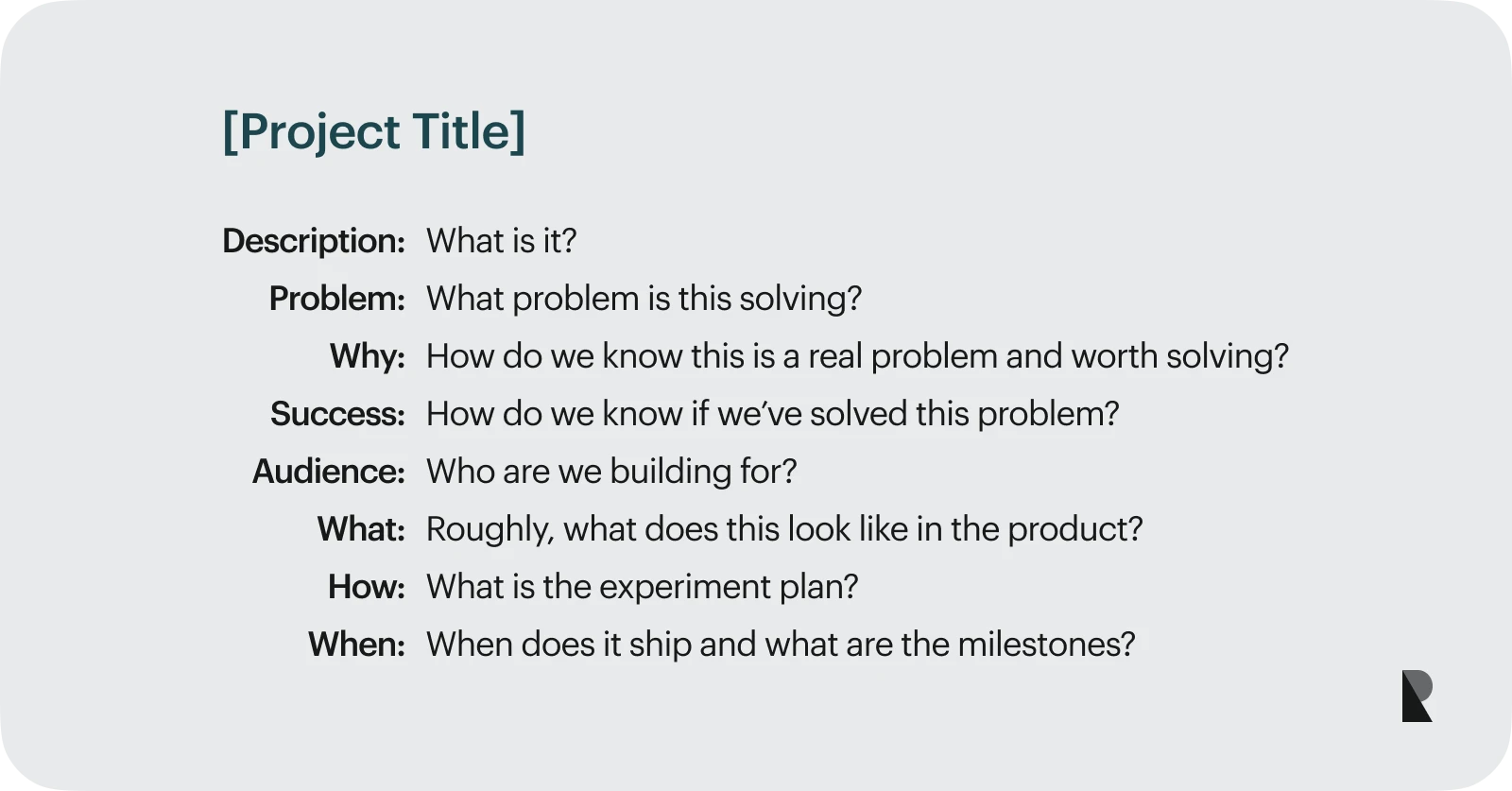
Screenshot of Lenny’s PRD via Google Docs
Benefits of a well-written PRD
Perfecting PRDs can make a massive difference in creating and implementing strategies. Let's review how a well-written product requirements document can benefit your team.
- It can align your team. Think of a PRD as the most accurate reference of what to build and why. It ensures everyone on board is working towards the same goal.
- It increases efficiency. A well-coordinated team is crucial to developing a successful product. With a PRD at your disposal, the product team can get its priorities straight and focus on the critical goals of the project.
- It adapts to changing visions and demands. Maintaining a PRD is an iterative process that relies on regular updates, testing, and user feedback. As a result, your team can rely on it to develop innovative product solutions that your audience will love.
Start Strong with the Right Project Requirements
Project requirements go beyond giving your team a list of tasks and responsibilities. Done right, they empower the organization to deliver impactful results that exceed business objectives. They also uncover opportunities and turn insights into actionable strategies that help mitigate risks.
Don’t let your efforts go to waste. Ensure the success of your projects by prioritizing project requirements.
Oct 23, 2025
